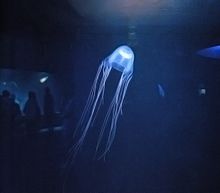Chironex yamaguchii, commonly known as ハブクラゲ (transliterated as habu-kurage, literally meaning "Viper Jellyfish" in Japanese) and as "hub jellyfish" due to erroneous machine translations, is a species of box jellyfish found in coastal waters around Japan, on Okinawa and the Ryukyu Islands, and in the Philippines.[2] Discovered in 2009, it is highly venomous and has been the cause of several deaths in Japanese waters.
| Chironex yamaguchii | |
|---|---|

| |
| Chironex yamaguchii at Enoshima Aquarium, Japan | |
| Scientific classification | |
| Domain: | Eukaryota |
| Kingdom: | Animalia |
| Phylum: | Cnidaria |
| Class: | Cubozoa |
| Order: | Chirodropida |
| Family: | Chirodropidae |
| Genus: | Chironex |
| Species: | C. yamaguchii
|
| Binomial name | |
| Chironex yamaguchii Lewis & Bentlage, 2009 [1]
| |
Taxonomy
editIn the past, this species was considered conspecific with Chiropsalmus quadrigatus found in Malaysia. That name however, is now considered as a nomen dubium and it is no longer recognized as a separate species.[3] It has now been established that Chironex yamaguchii is a different species and is more closely related to Chironex fleckeri, however, the name Chiropsalmus quadrigatus is widely used in the literature.[2]
Description
editThe medusa is box-shaped and has a maximum height of about 110 millimetres (4.3 in) which is only about one half to one third the size of Chironex fleckeri. On average, however, the animals are much smaller, being more typically 60 millimetres (2.4 in) in height. The maximum inter-radial diameter is 95 millimetres (3.7 in). The outer surface of the bell is smooth in adults, however the bells of juvenile jellyfish are warty. There are four short stalks known as pedalia which carry up to nine tentacles, but on average each bears only seven tentacles (compared with up to fifteen tentacles in Chironex fleckeri). The nematocyst threads are lavender.[4]
The manubrium is cross-shaped with lancet-shaped lips. It measures only about three quarters of the bell height. Each of the four rhopalia has six eyes, two with lenses, and two each of slot and pit pigment eyes. The statolith is oval and is located at the base of each rhopalium. There are eight different types of stinging cells.[4]
Venom
editThis box jellyfish is highly venomous. The stings cause great pain and have caused several deaths in Japanese waters. The symptoms include cardiac arrest and respiratory failure with acute pulmonary oedema.[2]
References
edit- ^ Collins, Allen G. (2015). "Chironex yamaguchii Lewis & Bentlage, 2009". WoRMS. World Register of Marine Species. Retrieved 2015-05-25.
- ^ a b c Lewis, Cheryl; Bentlage, Bastien (2009). "Clarifying the identity of the Japanese Habu-kurage, Chironex yamaguchii, sp. nov. (Cnidaria: Cubozoa: Chirodropida)" (PDF). Zootaxa. 2030: 59–65. ISSN 1175-5334.
- ^ "WoRMS - World Register of Marine Species - Chiropsoides quadrigatus (Haeckel, 1880)". www.marinespecies.org. Retrieved 2019-03-06.
- ^ a b Oba, A.; Hidaka, M.; Iwanaga, S.: Nematocyst composition of the cubomedusan Chiropsalmus quadrigatus changes with growth. Hydrobiologia, 530/531, 173–177, Dordrecht 2004 PDF.